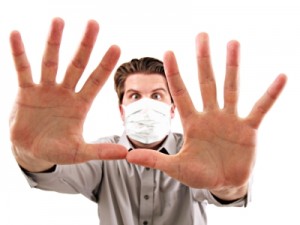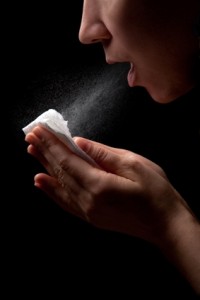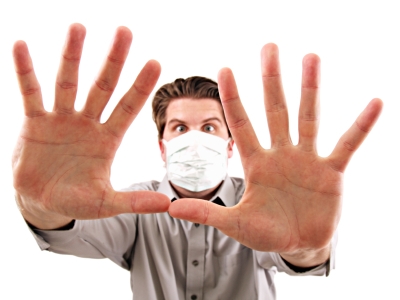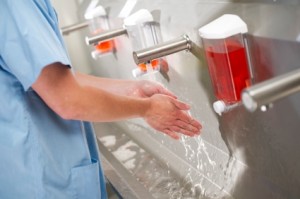 A whole variety of health risks lie in wait in places you come in contact with throughout your everyday life. There may be very little you can do to spare yourself from falling prey to the common bacteria and viruses colonizing on your skin, in your bathtub, at the pool, the doctor’s office and in the nasal membranes of your coworkers… but in most instances, good hygiene is the only barrier that stands between you and the ill-effects of these nasty bugs.
A whole variety of health risks lie in wait in places you come in contact with throughout your everyday life. There may be very little you can do to spare yourself from falling prey to the common bacteria and viruses colonizing on your skin, in your bathtub, at the pool, the doctor’s office and in the nasal membranes of your coworkers… but in most instances, good hygiene is the only barrier that stands between you and the ill-effects of these nasty bugs.
When a minor case of the sniffles or a sore throat goes unchecked, these run of the mill infections may turn deadly. The following pathogens have several things in common; they can lead to serious and fatal illnesses that may prompt hospitalization, debilitating medical conditions, chronic health problems and raise the cost of health insurance.
1. The office
It starts innocently enough. You’re sitting on a bus going to work when someone starts coughing right next to you. The minute you step into the office, you are assaulted by the uncontrollable sneezing of your co-worker. That shower of respiratory droplets is where you would find a malicious, intrusive bacterium called Group A streptococcus (GAS). Those who are stricken with strep throat can thank this strain of bacteria for getting them sick.
The bacterium commonly sets up camp in the throat and on the skin and is one of the most common pathogens of humans, according to the Oxford Journal, Clinical Infectious Diseases (CID). Strep is found in “respiratory droplets” so if you are infected and sneeze over someone, that person may become infected as well.
“If you drink from the same glass or eat from the same plate as the sick person, you could also become ill,” says Alison Patti, MPH spokesperson of the Centers for Disease Control and Prevention (CDC).
In the extreme, strep could develop into an invasive beast and travel to other parts of the body. Infections that find their way into your lungs or muscles are known as “invasive GAS diseases.” The most severe is necrotizing fasciitis, also known as “flesh-eating bacteria,” which does exactly what its name implies.
2. The handshake
Germs, germs, germs… It is estimated that we have a coterie of nearly 5,000 germs lurking on our hands at any given time throughout the day.
In fact, germs are so hearty and easy to pick up that 80 percent of infectious diseases including the transfer of Staphylococcus aureus or S. aureus are passed along to others through minor human contact such as shaking or holding hands. Dr. Philip M. Tierno, director of clinical microbiology at the Langone Medical Center, Department of Pathology in New York, and author of “The Secret Life of Germs” found that less than 50 percent of people wash their hands after using the bathroom.
Staphylococcus aureus (S. aureus or staph) is one of the most bothersome bugs behind infections of the skin and soft tissue, according to the Minnesota Department of Health.
While hospitals are the common culprits behind MRSA outbreaks, there has been an increase in community-acquired infections, according to the CDC. The most recent outbreaks have been in schools and locker rooms, spread easily through contact with personal items such as towels, bandages and razors.
Drug-resistant staph infections include:
Methicillin-resistant Staphylococcus aureus (MRSA),
Vancomycin-intermediate Staphylococcus aureus (VISA)
Vancomycin-resistant Staphylococcus aureus (VRSA)
“S. aureus, especially MRSA, is relatively easy to transmit and acquire via contact either directly like touching another, or indirectly like sharing equipment, clothing, uniforms, etc.,” explains Tierno. “There are two types of staph: MRSA, which is acquired in a hospital and CA-MRSA, which is acquired in common living areas. This latter staph is very pathogenic as well as toxigenic and can cause a serious infection and toxemia. Humans can carry S. aureus in their nostrils and certain areas of the skin.”
Staph infections may cause:
Bacteremia or sepsis
Pneumonia
Endocarditis (infection of the heart valves) that may lead to heart failure or stroke Osteomyelitis (bone infection).
3. The nursery
Your little one is miserable. His head is warm, he’s sneezing, coughing and floods of mucous is draining out of his nose. You may think he just caught a bad cold, but as time goes on his coughs are making a horrible “whoop” sound. What’s worse, the coughing spells are getting more frequent and more violent and this “cold” isn’t going away. Sound familiar?
The Bordetella Pertussis bacterium is the troublemaker behind “whooping cough” in infants.
People with Pertussis spread the disease by either coughing or sneezing while in close contact with others who then inhale the bacteria. This infection can result in serious complications such as middle ear infections, pneumonia, seizures, disorders of the brain and episodes of stopped breathing.
 4. The European trip
4. The European trip
Although you are probably scoffing at the very idea of contracting the measles at your age, you have permission to go ahead and scoff—if you’ve updated your shots.
In 2011, there was an unusual spike in Measles or Morbillivirus cases in the U.S. The outbreak has been linked to overseas travelers. This virus is a highly contagious respiratory disease that can thrive in the air and on surfaces for up to two hours.
“Measles and other childhood diseases are on the rise because of the misconceptions of parents who choose not to vaccinate their children for fear of autism or other diseases. That decision leaves them very prone to contract a variety of childhood diseases. Unfortunately their thinking is misguided,” Tierno says.
Measles symptoms includes a fever that reaches 105 degrees, runny nose, cough, swollen eyes that are sensitive to light, muscle pain and a severe rash across the face and neck.
A touch of the Measles can lead to serious complications such as pneumonia, encephalitis, bronchitis and death.













